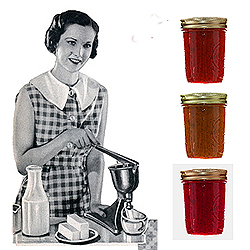
Although Jam making is quite easy to do there are some simple remedies and things to remember if your jam does go wrong during the cooking process This list contains most of the jam making problems you are likely to encounter.
1. Tough skinned fruit should be simmered before adding of sugar because sugar will make the fruit harder.
2. Soft skinned fruit (strawberries, raspberries etc) can be soaked in sugar first. This will have the opposite effect to point one and will keep the fruit whole in the final jam.
3. The sugar must be dissolved completely before the jam is boiled. This will make the jam set properly.
An easy way to test this is to dip a wooden spoon into the mix. Pull the spoon out and if there are no sugar crystals visible then the jam is ready to boil.
(You can warm the sugar in a bowl first if you want to speed up the dissolving process).
4. Don’t make jam in huge quantities as it will take too long to boil and don’t leave a lid on the jam when cooking it.
5. Testing the setting point: Put some of the jam on a large metal spoon and rest the spoon on an ice cube. Tip the spoon slightly and if the mixture has a thin crinkly skin on it then its set.
(If it hasn’t set boil it again for another five minutes and do the test again).

6. If you get a scum rising to the surface of the jam wait until you hav a jam set and stir in a small lump of butter to disperse it.
7. After the jam has set, allow it to settle for 15 minutes as this will prevent the fruit from rising to the top when put into the jars.
8. Don’t put labels onto the jars until the jam has cooled properly. I would also suggest putting some sellotape (sticky back plastic) over the jars to protect them from spilt jam and temperature changes.
9. Store the jam in a cool dry place. Too much light is not good for storage and too steamy will encourage mould to develop on the jam.
10. If things do go wrong tip it back in the pan and add a juice of a lemon and bring it back to the boil again. If you find mould has developed on your jarred jam you can remove the top 1cm and you should find the jam underneath is unaffected.
11. You shouldn’t need commercially available pectin at all if you follow these tips when cooking your jam.

